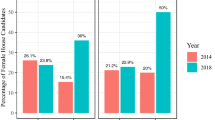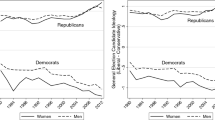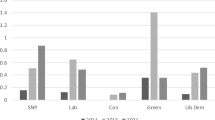Abstract
While the number of women standing as candidates in federal elections in Canada has surged, it is unclear how voters respond to the increased presence of women in politics. In this paper, we study who votes for women candidates in four recent federal elections. Using Canadian Election Study data and biographical information on candidates for the 2011, 2015, 2019 and 2021 federal elections, we examine the impact of the presence of women candidates on voting in Canadian elections. Leveraging the individual-level nature of our data, we also explore heterogeneity in voting for women candidates, with specific attention to patterns of gender affinity voting, and the moderating effects of gender consciousness and gender attitudes on voting for women. Our findings are similar to previous work in failing to show much evidence of an electoral disadvantage for women candidates. We also find very little evidence of heterogeneity in this basic null effect in terms of voters’ gender or their gender attitudes.




Similar content being viewed by others
Notes
We acknowledge that focusing on a dichotomous operationalization of candidate sex limits our understanding of the role of gender and gender identity in politics (Bittner and Goodyear-Grant 2017). However, the survey and candidate data we use do not allow moving beyond this dichotomy. While newer data collection efforts (Johnson et al. 2021) provide information on candidates who identify as non-binary for the 2019 election, the share of candidates for whom this applies is too small to quantitatively assess patterns of affinity voting for this specific group.
While Durovic and Mayer (2022) find evidence of a connection between sexist attitudes and voting for radical right wing parties this only holds for Zemmour’s Reconquête! party and not for the Rassemblement national.
We acknowledge that this approach does not allow confirming whether it is indeed the characteristics of a candidate (and their gender in particular) that motivate voters’ choices versus some other determinants of the vote choice. An alternative approach would be to make use of questions that ask voters directly about the motivations for their vote choice. There are some doubts, however, about voters’ ability of introspection (see, e.g., Nisbett and Wilson 1977).
The inclusion of party dummies means that we effectively account for all party-specific characteristics that might affect voters’ choices, including party leaders and their gender.
Given that previous work has shown that the incumbency effect in Canada is similarly strong for men and women candidates (Sevi 2023), we focus on the overall incumbency effect across candidates.
Note that the main effect of respondent’s sex is a constant across choice alternatives and is therefore not estimated.
References
Aaldering, Loes, and Daphne Joanna Van Der Pas. 2020. Political leadership in the media: gender bias in leader stereotypes during campaign and routine times. British Journal of Political Science 50 (3): 911–931.
Allen Stevens, Benjamin, Islam Md. Mujahedul, Roosmarijn De Geus, Jonah Goldberg, John R. McAndrews, Alex Mierke-Zatwarnicki, Peter John Loewen, and Daniel Rubenson. 2019. Local candidate effects in Canadian elections. Canadian Journal of Political Science 52 (1): 83–96.
Alvarez, R Michael, and Jonathan Nagler. 1998. When politics and models collide: estimating models of multiparty elections. American Journal of Political Science 42: 55–96.
Anduiza, Eva, and Guillem Rico. 2022. Sexism and the far-right vote: the individual dynamics of gender backlash. American Journal of Political Science. https://doi.org/10.1111/ajps.12759.
Badas, Alex, and Katelyn E. Stauffer. 2019. Voting for women in nonpartisan and partisan elections. Electoral Studies 57: 245–255.
Beauregard, Katrine, and Jill Sheppard. 2021. Antiwomen but proquota: disaggregating sexism and support for gender quota policies. Political Psychology 42 (2): 219–237.
Bird, Karen, Samantha D. Jackson, R. Michael McGregor, Aaron A. Moore, and Laura B. Stephenson. 2016. Sex (and ethnicity) in the city: affinity voting in the 2014 Toronto mayoral election. Canadian Journal of Political Science 49 (2): 359–383.
Bittner, Amanda, and Elizabeth Goodyear-Grant. 2017. Sex isn’t gender: Reforming concepts and measurements in the study of public opinion. Political Behavior 39 (4): 1019–1041.
Blais, André, Elisabeth Gidengil, Agnieszka Dobrzynska, Neil Nevitte, and Richard Nadeau. 2003. Does the local candidate matter? Candidate effects in the Canadian election of 2000. Canadian Journal of Political Science 36 (3): 657–664.
Campbell, Rosie, and Oliver Heath. 2017. Do women vote for women candidates? Attitudes toward descriptive representation and voting behavior in the 2010 British election. Politics & Gender 13 (2): 209–231.
Cassese, Erin C., and Mirya R. Holman. 2019. Playing the woman card: Ambivalent sexism in the 2016 US presidential race. Political Psychology 40 (1): 55–74.
Christley, Olyvia R. 2022. Traditional gender attitudes, nativism, and support for the radical right. Politics & Gender 18 (4): 1141–1167.
Conroy, Meredith, Danielle Joesten Martin, and Kim L. Nalder. 2020. Gender, sex, and the role of stereotypes in evaluations of Hillary Clinton and the 2016 presidential candidates. Journal of Women, Politics & Policy 41 (2): 194–218.
Daoust, Jean-François, and Thomas Gareau Paquette. 2023. Is Quebec independence still key in making sense of Canadian elections? A longitudinal analysis (2000–2021). Regional & Federal Studies. https://doi.org/10.1080/13597566.2023.2233422.
Darcy, Robert, and Sarah Slavin Schramm. 1977. When women run against men. Public Opinion Quarterly 41 (1): 1–12.
De Geus, Roosmarijn, Elizabeth Ralph-Morrow, and Rosalind Shorrocks. 2022. Understanding ambivalent sexism and its relationship with electoral choice in Britain. British Journal of Political Science 52 (4): 1564–1583.
Dhima, Kostanca, Sona N. Golder, Laura B. Stephenson, and Karine Van der Straeten. 2021. Permissive electoral systems and descriptive representation. Electoral Studies 73: 102381.
Dolan, Kathleen. 1998. Voting for Women in the “Year of the Woman.” American Journal of Political Science 42 (1): 272–293.
Dolan, Kathleen. 2008. Is there a “gender affinity effect” in American politics? Information, affect, and candidate sex in US House elections. Political Research Quarterly 61 (1): 79–89.
Dolan, Kathleen. 2010. The impact of gender stereotyped evaluations on support for women candidates. Political Behavior 32 (1): 69–88.
Dolan, Kathleen, and Timothy Lynch. 2015. Making the connection? Attitudes about women in politics and voting for women candidates. Politics, Groups, and Identities 3 (1): 111–132.
Durovic, Anja, and Nonna Mayer. 2022. Wind of change? The reconfiguration of gender gaps in the 2022 French presidential election. Revue Francaise De Science Politique 72 (4): 463–484.
Fournier, Patrick, Fred Cutler, Stuart Soroka and Dietlind Stolle. 2011. The 2011 Canadian Election Study. URL: https://ces-eec.arts.ubc.ca/english-section/surveys/
Fournier, Patrick, Fred Cutler, Stuart Soroka and Dietlind Stolle. 2015. The 2015 Canadian Election Study. URL: https://ces-eec.arts.ubc.ca/english-section/surveys/
Giger, Nathalie, Anne Maria Holli, Zoe Lefkofridi, and Hanna Wass. 2014. The gender gap in same-gender voting: The role of context. Electoral Studies 35: 303–314.
Glick, Peter, and Susan T. Fiske. 1996. The Ambivalent Sexism Inventory: Differentiating hostile and benevolent sexism. Journal of Personality and Social Psychology 70 (3): 491.
Glick, Peter, and Susan T. Fiske. 2001. An ambivalent alliance: Hostile and benevolent sexism as complementary justifications for gender inequality. American Psychologist 56 (2): 109.
Goodyear-Grant, Elizabeth, and Julie Croskill. 2011. Gender affinity effects in vote choice in Westminster systems: Assessing “flexible” voters in Canada. Politics & Gender 7 (2): 223–250.
Goodyear-Grant, Elizabeth, and Erin Tolley. 2019. Voting for one’s own: Racial group identification and candidate preferences. Politics, Groups, and Identities 7 (1): 131–147.
Hale, Isaac. 2023. Racial attitudes and vote choice in national canadian elections. Canadian Journal of Political Science/revue Canadienne De Science Politique 56 (3): 656–680.
Heath, Oliver, Gilles Verniers, and Sanjay Kumar. 2015. Do muslim voters prefer muslim candidates? Co-religiosity and voting behaviour in India. Electoral Studies 38: 10–18.
Huddy, Leonie, and Nayda Terkildsen. 1993. The consequences of gender stereotypes for women candidates at different levels and types of office. Political Research Quarterly 46 (3): 503–525.
Johnson, Anna, Erin Tolley, Melanee Thomas, and Marc André Bodet. 2021. A new dataset on the demographics of canadian federal election candidates. Canadian Journal of Political Science 54 (3): 717–725.
Kendall, Chad, and Marie Rekkas. 2012. Incumbency advantages in the Canadian Parliament. Canadian Journal of Economics 45 (4): 1560–1585.
McGregor, R Michael, Aaron Moore, Samantha Jackson, Karen Bird, and Laura B. Stephenson. 2017. Why so few women and minorities in local politics?: Incumbency and affinity voting in low information elections. Representation 53 (2): 135–152.
Nadeau, Richard, and Éric. Bélanger. 2012. Quebec versus the Rest of Canada, 1965–2006. In The Canadian Election Studies: Assessing Four Decades of Influence, ed. Mebs Kanji, Antoine Bilodeau, and Thomas J. Scotto, 136–153. Vancouver: UBC Press.
Nisbett, Richard E., and Timothy D. Wilson. 1977. Telling more than we can know: verbal reports on mental processes. Psychological Review 84 (3): 231.
Off, Gefjon. 2023. Gender equality salience, backlash and radical right voting in the gender equal context of Sweden. West European Politics 46 (3): 451–476.
Plutzer, Eric, and John F. Zipp. 1996. Identity politics, partisanship, and voting for women candidates. Public Opinion Quarterly 60 (1): 30–57.
Polacko, Matthew, Simon Kiss, and Peter Graefe. 2022. The changing nature of class voting in Canada, 1965–2019. Canadian Journal of Political Science/revue Canadienne De Science Politique 55 (3): 663–686.
Pruysers, Scott. 2022. Gender affinity voting and the 2017 municipal elections in Québec City and Montréal. In A Tale of Two Cities: Voting Behaviour in Local Elections in Montreal and Quebec City, ed. Éric Bélanger, Cameron Anderson and Michael McGregor. Toronto: University of Toronto Press.
Rivard, Alex B., and Mackenzie Lockhart. 2022. Government preferences, vote choice and strategic voting in Canada. Canadian Journal of Political Science/revue Canadienne De Science Politique 55 (3): 721–733.
Sanbomatsu, Kira. 2002. Gender stereotype and vote choice. American Journal of Political Science 46 (1): 20–34.
Schwarz, Susanne, and Alexander Coppock. 2022. What have we learned about gender from candidate choice experiments? A meta-analysis of 67 factorial survey experiments. Journal of Politics 84 (2): 655–668.
Sevi, Semra. 2021. Who runs? Canadian federal and Ontario provincial candidates from 1867 to 2019. Canadian Journal of Political Science 54 (2): 471–476.
Sevi, Semra. 2023. Is incumbency advantage gendered? Legislative Studies Quarterly 48 (1): 145–163.
Sevi, Semra, Vincent Arel-Bundock, and André Blais. 2019. Do women get fewer votes? No. Canadian Journal of Political Science 52: 201–210.
Stephenson, Laura B, Allison Harell, Daniel Rubenson and Peter John Loewen. 2020. 2019 Canadian Election Study-Online Survey. URL: https://doi.org/10.7910/DVN/DUS88V
Stephenson, Laura B, Allison Harell, Daniel Rubenson and Peter John Loewen. 2022. 2021 Canadian Election Study. URL: https://doi.org/10.7910/DVN/XBZHK
Welch, Susan, and Donley T. Studlar. 1988. The effects of candidate gender on voting for local office in England. British Journal of Political Science 18 (2): 273–281.
Acknowledgements
This project was initiated while all co-authors were affiliated with the Canada Research Chair in Electoral Democracy at the Université de Montréal. Previous versions of this paper were presented at the CSDC Graduate Student Conference, Québec (1–2 April 2022), the Political Studies Association’s Undergraduate Conference (8 April 2022), and at the 2022 CPSA Conference (30 May–3 June 2022). We thank all participants for comments and suggestions. We are also grateful to students of the course POL3015, les élections at the Université de Montréal for the feedback they provided through a review-task.
Author information
Authors and Affiliations
Corresponding author
Additional information
Publisher's Note
Springer Nature remains neutral with regard to jurisdictional claims in published maps and institutional affiliations.
Supplementary Information
Below is the link to the electronic supplementary material.
Rights and permissions
Springer Nature or its licensor (e.g. a society or other partner) holds exclusive rights to this article under a publishing agreement with the author(s) or other rightsholder(s); author self-archiving of the accepted manuscript version of this article is solely governed by the terms of such publishing agreement and applicable law.
About this article
Cite this article
Gareau-Paquette, T., Léal, A., Leblanc, J. et al. Voting for women in recent Canadian elections. Fr Polit 22, 45–63 (2024). https://doi.org/10.1057/s41253-024-00236-5
Accepted:
Published:
Issue Date:
DOI: https://doi.org/10.1057/s41253-024-00236-5




